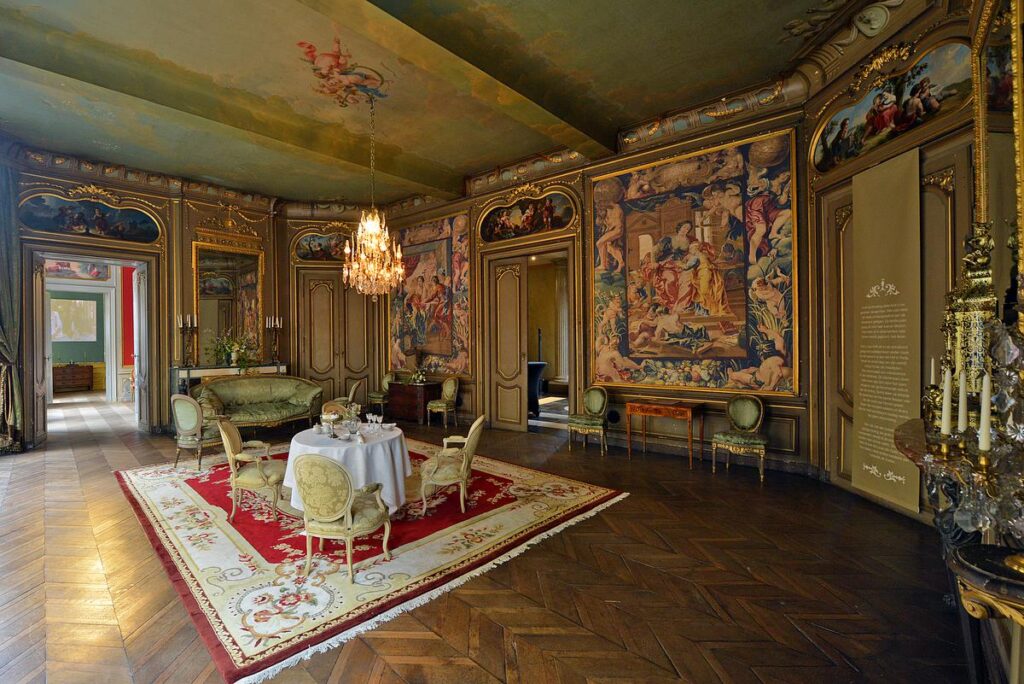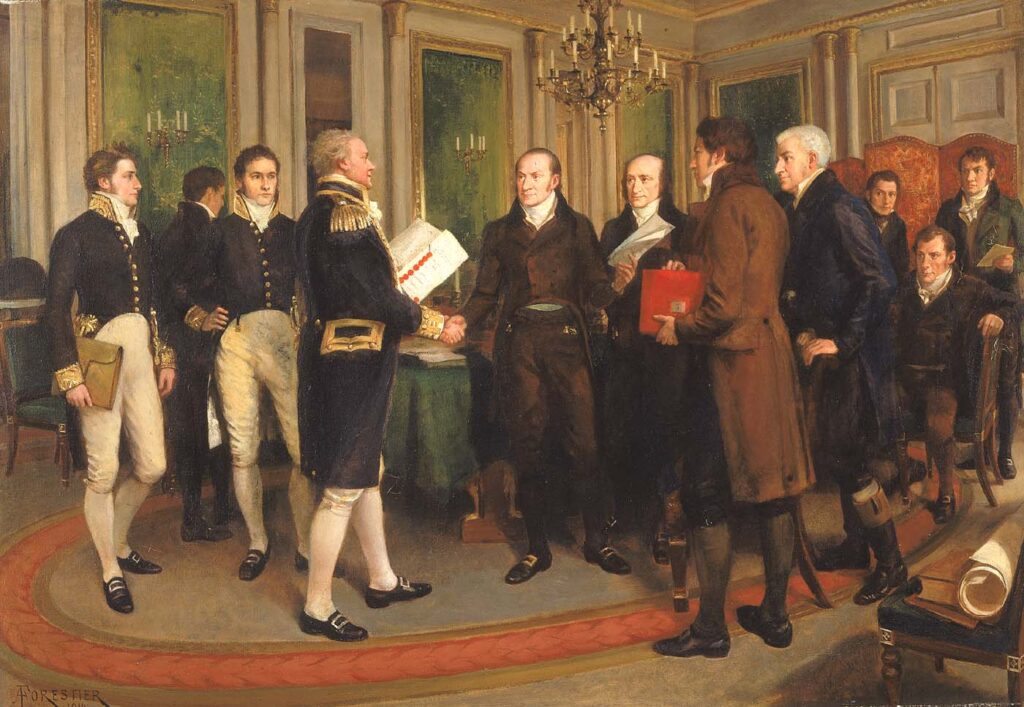Please find driving directions below the main text
Bank account of “National Trust Belgium” (NTAB)
BE17 0016 2443 2021
Gent, the proud city
In the morning we explore two historic neighbourhoods of Ghent: the ‘Patershol’ (Monks’ Hole) and the Prinsenhof (Prince’s Court). More background information about these districts can be found at the end of this post.
For lunch, restaurant Borluut on the Korenmarkt prepares a Flemish classic for us, ‘Gentse waterzooi’, a rich broth with chopped vegetables and chicken that is thickened with a creamy liaison.

Hôtel d’Hane-Steenhuyse, Gent
In the afternoon we have an ‘upstairs-downstairs’ tour in the fully restored stately mansion (‘hôtel privé’) of the noble family d’Hane Steenhuyse (18th century rococo). We also visit the nearby House Vander Haeghen.
In one of the rooms of the House d’Hane Steenhuyse, the Treaty of Ghent was signed, the peace treaty that ended the War of 1812 between the United States and the United Kingdom. You can take a picture of the plaque at a building in nearby Veldstraat, No. 47, where the American diplomats stayed and was one of the locations where the treaty was negotiated. John Quincy Adams, who later became the 6th US president, led the American delegation.

Treaty of Ghent. The leading British delegate Lord Gambier is shaking hands with the American leader John Quincy Adams. The British Undersecretary of State for War and the Colonies, Henry Goulburn, is carrying a red folder.
The Arnold Vander Haeghen House is suffused with the spirit of the belle epoque . The most attractive rooms include the Chinese Salon and a reconstruction of the study of Ghent’s Nobel Prize winner in literature, Maurice Maeterlinck.
All our visits, morning and afternoon, are guided and commented in English and in Dutch.
The Prinsenhof is a historic neighborhood in Ghent, around the former Hof ten Walle, the residence of the Viscount of Ghent. Hof ten Walle was the birthplace of Emperor Charles V (February, 1500) and was known as the Prinsenhof from then on. In the 17th century, the waning days of the Spanish Netherlands, the Prinsenhof fell into disrepair . Almost nothing remains of the original domain: the neighborhood was gradually absorbed by the city and now serves as a residential area. The only remnant of the old Hof ten Walle is the ‘Donkere Poort’, the large arched gate of the house of Baron Jean-Baptiste Bethune (1821-1894) in the Prinsenhofstraat.
The Patershol is an old neighborhood in the historic center of Ghent with a closed street pattern that it has preserved from the Middle Ages, separated from the old city center by the Leie river. At the end of the 15th century the Patershol became a wealthy district when lawyers, magistrates, tradesmen and craftsmen moved in. But at the beginning of the 19th century, when the industrialization took off, workers came to live there and many of the large buildings were demolished or subdivided into smaller workers’ homes. When industry and workers moved to the suburbs at the end of that century, the Patershol with its narrow street pattern gradually became a deprived neighborhood or ghetto, albeit with an artistic bohémien inspiration. This condition continued until the 1970s, when the old quarter, thanks to its central location and historical value, attracted city authorities and private investors who took care of restoration, renovation and tourist upgrading. The cobblestone pavement was largely preserved. The beginning of the rescue of the neighborhood has already started in the aftermath of May ’68 by the Ghent artist scene, socially engaged adolescents, academy students, architects and monument caretakers. Under pressure from neighborhood actions which attracted a lot of media attention there was no way back for the restoration of the Patershol. The district was protected as a cityscape in 1981 and now houses many small cafes and restaurants.
How to get at the (Sint-)Veerleplein
We recommend coming to Gent by train. Take tram no. 1 from platform 2 on your left when leaving the train station (Sint-Pietersstation).
There is a tram every 10 minutes that takes you to Veerleplein (Gravensteen) in 15 minutes.
If you come by car, the easiest way is to you leave it in the Zuid parking, on Zuidparklaan, which is located on the edge of the city centre when you come from the highway.
Trams can be found in the immediate vicinity (towards the shopping mall). From platform 1, take tram no. 4.
A tram runs every 10-12 minutes and takes you to Veerleplein (Gravensteen) in 10 minutes.
You can also walk along the Vlaanderenstraat and the very city centre, which would take 20 minutes.
If you have an updated navigator and are not afraid to brave the city center of Ghent by car, the nearest (underground) parking is ‘Vrijdagmarkt’, a 6-minutes walk along the Kraanlei (500 meters) to the Veerleplein and its medieval Gravensteen castle.